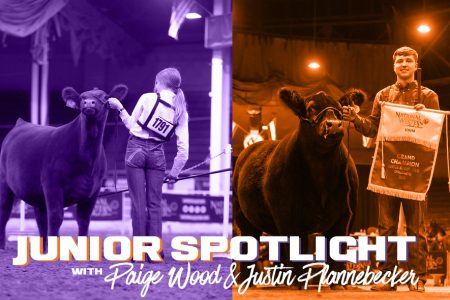
Performance Hereford Heifer Official Results
Provided by, Chris Mullinix, Kansas State University
First, let us start by saying this is one of the more difficult picture classes you may ever see. We think there is logical justification for many placings. However, we do find it important to look at the performance information available and be mindful of how those differences may affect the marketing opportunities outlined in the production scenario. Also, please notice in the performance data the difference in ages between the heifers. 1 and 2 are approximately two months younger – a difference that is rather significant for young fall heifer calves like these.
2-4-1-3 Cuts: 2-3-2
2413 is my ranking of the Hereford Fall Heifer Calves. In a challenging class, 2 and 4 offer performance values more in line with goals of this ranch. I opted for the balance and female quality in 2, as the greener conditioned female reads with more future. The late October heifer’s neater fronted, smoother shouldered and more correct in the build of her hip and hind leg. Throw in her eye pigmentation, birth to yearling spread and carcass predictors and I can see her calves drawing interest from either commercial cattlemen or junior exhibitors. On the other hand, 4’s the class leader in body volume and growth genetics. But the plain fronted yellow heifer is also a bit deep in her chest and open in her shoulder.
Still, I sided with her practical body type and extra power to beat 1 in the middle. Her sons can target bull buyers looking to enhance gain and muscularity in the next generation. Now the more feminine fronted 1 reads as strong as any in her maternal columns. But the short bodied heifer is a bit off in her hind leg set and charts the poorest in her growth EPD’s.
In a contrasting bottom, I sided with the refinement and maternal character of the more moderate 1. Her low input look and superior calving ease genetics are a better fit for this limited resource program. Now if you prefer the extra length and apparent growth in 3, I can’t argue. But at the same token, she’s the off quality, plain appearing heifer that’s awkward in the set of her hind leg. Genetically, she charts on the wrong side of breed average in every calving ease, maternal and carcass related trait. Thank you.
Original Scenario Information
| Number | Date of Birth |
CED | Birth Weight |
Weaning Weight |
Yearling Weight |
Milk | Marbling | REA | $CHB |
| 1 | 11/1 | +2.9 | +0.1 | +46 | +77 | +23 | +.13 | +.28 | 23 |
| 2 | 10/30 | +1.5 | +2.0 | +57 | +98 | +23 | +.14 | +.41 | 29 |
| 3 | 9/4 | -1.0 | +4.0 | +53 | +94 | +16 | +.01 | +.11 | 24 |
| 4 | 9/3 | +1.1 | +3.2 | +58 | +103 | +20 | +.10 | +.37 | 27 |
| Breed Averages | +0.9 | +3.3 | +47 | +77 | +19 | +.07 | +.30 | 22 | |
Rank these heifers as replacement females in a purebred Hereford operation located in western Kansas. Commercial bull sales have always been the primary income source for this ranch and they’ve seen exciting growth in that market in recent years. Management has put selection pressure on cattle with a strong birth to yearling spread that can still address the carcass needs of potential commercial customers. The program also caters to a growing junior show heifer market. Limited resources require moderate framed, low input cattle that can thrive with minimal feed supplementation.


